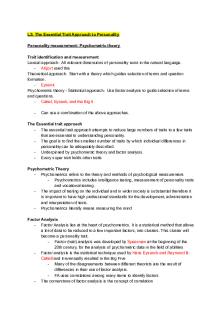Personality – Nomothetic Approach PDF

| Title | Personality – Nomothetic Approach |
|---|---|
| Course | Developing Individual in Society |
| Institution | University of Lincoln |
| Pages | 4 |
| File Size | 73.1 KB |
| File Type | |
| Total Downloads | 35 |
| Total Views | 134 |
Summary
Delivered by Dr Ava Horowitz...
Description
Nomothetic vs Idiographic Approaches ◦ Nomothetic Approach - look for patterns of personality - assesses similarities and differences between personalities - compares large samples of people - looks at ‘patterns of difference’. ◦ Idiographic Approach - understand the unique structures of individuals’ personalities - related to ‘patterns of difference’ - may compare smaller samples of people. ◦ Phenomenology - subjective experience - believes in self-determination & free will - people are not a consequence of biology or past experience - humanistic - views people as good and self-perfecting. Multi Trait Theories ◦ Personality Traits - enduring patterns of behaviour that are relatively consistent across a wide variety of contexts and situations. ◦ Traits vs States - Person’s state is the current condition they’re in, can be context dependent and changeable - Traits are a person’s disposition so should stay mostly consistent regardless of context. ◦ Normal distribution of traits - average person has some degree of all traits in them - e.g., trusting/shy/lazy. ◦ Factor Analysis of Traits - Factors = clusters - clusters are traits that can be named and identified within a person
Cattell’s Trait Theory ◦ Bottom-Up Theory ◦ Assesses what people are like and then use factor analysis to look for patterns and break down patterns of behaviour. ◦ 16 PF (personality factors) discovered - 16 source traits - the basic traits of all personalities. ◦ The PF found have been supported in over 60 studies. ◦ Often has been revised. Eysenck’s Trait Theory ◦ Top-Down Theory ◦ Inspired by Hippocrates 4 humours theory and Jung’s introvert/extrovert theory. ◦ Involves 2 dimensions - stable vs unstable - introverted vs extroverted. ◦ Outdated now but was the most popular theory for long time. The Big Five ◦ 5 trait clusters consistently found by different researchers. ◦ Openness to experience ◦ Conscientiousness (careful v impulsive) ◦ Extraversion ◦ Agreeableness ◦ Neuroticism ◦ OCEAN
Situationism and Interactionism ◦ Situationism - opposes trait theories - people’s behaviours are not consistent across different contexts, situation influences how people act not their disposition. ◦ Funder & Ozer - situations are no better than traits at predicting differences in behaviour - 30% success rates in predictions for each. ◦ Interactionism - situation and personality interact to determine behaviour - mix of trait theory and situationism. 4 Levels of Interaction ◦ Effect Strength - strength of a trait can vary - situations may cause traits to become more dominant or passive. ◦ Opposing Effects - situation can have opposing effects depending on the person’s trait - extrovert talk more when stressed, introvert talk less. ◦ Choice Effects - different personalities choose different situations - extroverts go to busier places than introverts. ◦ Participation Effects - different personalities may cause other people to change or change the situation - e.g., playing tennis with a competitive person compared to noncompetitive. Constructivism ◦ Personality/behaviour can be influenced by beliefs - social beliefs, self-beliefs, other people’s beliefs about you. ◦ Observer has expectancy of target. Observer acts in a certain way towards target. Target responds. Observer interprets target’s response. Target interprets their own response. ◦ E.g., when someone expects you to get annoyed at something they’ve done and so you get annoyed when you normally wouldn’t....
Similar Free PDFs

Nomothetic Approaches to Personality
- 14 Pages

Personality Disorders
- 5 Pages

Literal Approach
- 3 Pages

Interactionist Approach
- 1 Pages

Personality Tests
- 6 Pages

Personality Essay
- 4 Pages

Legal Personality
- 17 Pages

Personality Paper
- 9 Pages
Popular Institutions
- Tinajero National High School - Annex
- Politeknik Caltex Riau
- Yokohama City University
- SGT University
- University of Al-Qadisiyah
- Divine Word College of Vigan
- Techniek College Rotterdam
- Universidade de Santiago
- Universiti Teknologi MARA Cawangan Johor Kampus Pasir Gudang
- Poltekkes Kemenkes Yogyakarta
- Baguio City National High School
- Colegio san marcos
- preparatoria uno
- Centro de Bachillerato Tecnológico Industrial y de Servicios No. 107
- Dalian Maritime University
- Quang Trung Secondary School
- Colegio Tecnológico en Informática
- Corporación Regional de Educación Superior
- Grupo CEDVA
- Dar Al Uloom University
- Centro de Estudios Preuniversitarios de la Universidad Nacional de Ingeniería
- 上智大学
- Aakash International School, Nuna Majara
- San Felipe Neri Catholic School
- Kang Chiao International School - New Taipei City
- Misamis Occidental National High School
- Institución Educativa Escuela Normal Juan Ladrilleros
- Kolehiyo ng Pantukan
- Batanes State College
- Instituto Continental
- Sekolah Menengah Kejuruan Kesehatan Kaltara (Tarakan)
- Colegio de La Inmaculada Concepcion - Cebu







